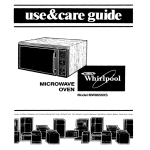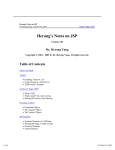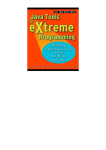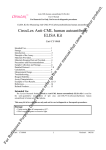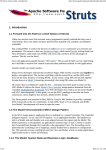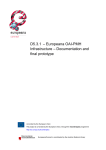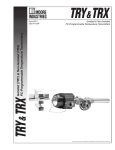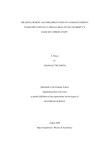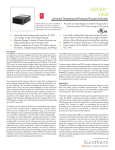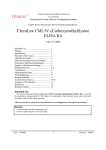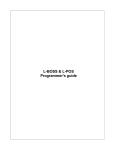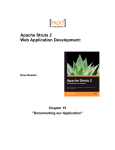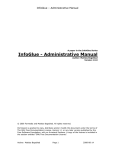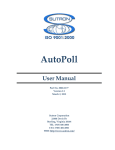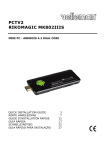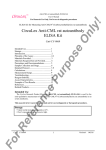Download FAKULT¨AT F¨UR INFORMATIK A Web
Transcript
FAKULTÄT FÜR INFORMATIK
DER TECHNISCHEN UNIVERSITÄT MÜNCHEN
Bachelorarbeit in Informatik
A Web-Based Front End to
Scenario-Based Procurement
with Quantity Rebates
Philipp Reichart
FAKULTÄT FÜR INFORMATIK
DER TECHNISCHEN UNIVERSITÄT MÜNCHEN
Bachelorarbeit in Informatik
A Web-Based Front End to Scenario-Based
Procurement with Quantity Rebates
Eine Web-Basierte Schnittstelle zu
Szenario-Basierter Beschaffung mit
Mengenrabatten
Author:
Supervisor:
Advisor:
Date:
Philipp Reichart
Prof. Dr. Martin Bichler
Dipl.-Inf. Stefan Schneider
13. November 2009
I assure the single handed composition of this bachelor’s thesis only supported
by declared resources,
München, 13. November 2009
Philipp Reichart
Abstract
Diese Arbeit beschreibt die Umsetzung einer web-basierten Schnittstelle zum SPQR-System mit Fokus auf Benutzbarbkeit, Einfachheit,
Wartbarkeit und Best Practices bei zeitgemäßer Entwicklung von JavaWebanwendungen. Die grundlegenden Technologien zur Erstellung
web-basierter Anwendungen in der Programmiersprache Java werden
erklärt und die Wichtigkeit der Verwendung von Frameworks zur Entwicklung eleganter, erweiterbarer und wartbarer Lösungen dargestellt.
Verschiedene Metriken erleichtern und begründen die Auswahl des geeignetsten Frameworks aus einer Vielzahl von Kandidaten. Es folgt die
Beschreibung des letztendlich verwendeten Frameworks sowie des Umsetzungsprozess mit besonderem Augenmerk auf die nutzenstiftende
und intuitiv verständliche Darstellung von Schlüsselkomponenten.
i
Abstract
This thesis describes the effort to implement a web-based front
end to the SPQR system with focus on ease of use, simplicity, maintainability and best practices in current Java web application development. The fundamental technologies used in web-based applications
in the Java Programming Language are introduced along side the importance of using a web framework for developing elegant, extensible
and maintainable solutions. Various metrics for selecting the best fit
framework from a multitude of candidates are presented. The final
choice and implementation process is described with special attention
paid to providing added value by intuitively visualizing key components.
ii
Contents
1 Problem Statement
1
2 Analysis
2.1 Requirements . . . . . . . . .
2.2 Class Diagram of Data Model
2.3 Main Functionality . . . . . .
2.4 Use Cases and Workflows . . .
2.5 Visualization of Key Elements
.
.
.
.
.
.
.
.
.
.
.
.
.
.
.
.
.
.
.
.
.
.
.
.
.
.
.
.
.
.
.
.
.
.
.
.
.
.
.
.
.
.
.
.
.
.
.
.
.
.
.
.
.
.
.
.
.
.
.
.
.
.
.
.
.
.
.
.
.
.
.
.
.
.
.
.
.
.
.
.
.
.
.
.
.
.
.
.
.
.
1
1
2
3
4
4
3 Technologies in Web-Based Applications
3.1 Fundamentals of web-based applications .
3.2 Web-based applications in Java . . . . . .
3.3 Web Frameworks . . . . . . . . . . . . . .
3.4 Metrics for choosing a framework . . . . .
3.4.1 Ease of learning . . . . . . . . . . .
3.4.2 Ease of development . . . . . . . .
3.4.3 Maturity and Future Proofness . .
3.5 Candidate Frameworks . . . . . . . . . . .
3.5.1 Plain Servlets and Java Server Page
3.5.2 Struts 1 . . . . . . . . . . . . . . .
3.5.3 Stripes . . . . . . . . . . . . . . . .
3.5.4 Spring MVC . . . . . . . . . . . . .
3.5.5 Java Server Faces . . . . . . . . . .
3.5.6 Wicket . . . . . . . . . . . . . . . .
3.5.7 WebWork 2.x and Struts 2 . . . . .
3.6 Charting Frameworks . . . . . . . . . . . .
. . . . .
. . . . .
. . . . .
. . . . .
. . . . .
. . . . .
. . . . .
. . . . .
(JSP)s
. . . . .
. . . . .
. . . . .
. . . . .
. . . . .
. . . . .
. . . . .
.
.
.
.
.
.
.
.
.
.
.
.
.
.
.
.
.
.
.
.
.
.
.
.
.
.
.
.
.
.
.
.
.
.
.
.
.
.
.
.
.
.
.
.
.
.
.
.
.
.
.
.
.
.
.
.
.
.
.
.
.
.
.
.
.
.
.
.
.
.
.
.
.
.
.
.
.
.
.
.
.
.
.
.
.
.
.
.
.
.
.
.
.
.
.
.
5
5
7
10
11
11
12
13
14
14
14
14
15
15
15
16
17
4 Implementation
4.1 Choice of Framework . . . . .
4.2 Code Structure . . . . . . . .
4.3 User Interface Design . . . . .
4.4 Visualization of Key Elements
4.5 Issues . . . . . . . . . . . . .
.
.
.
.
.
.
.
.
.
.
.
.
.
.
.
.
.
.
.
.
.
.
.
.
.
.
.
.
.
.
.
.
.
.
.
17
17
19
21
21
24
5 Conclusion
.
.
.
.
.
.
.
.
.
.
.
.
.
.
.
.
.
.
.
.
.
.
.
.
.
.
.
.
.
.
.
.
.
.
.
.
.
.
.
.
.
.
.
.
.
.
.
.
.
.
.
.
.
.
.
24
A Setup and User Documentation
26
A.1 Setup Instructions . . . . . . . . . . . . . . . . . . . . . . . . 26
A.2 User Manual . . . . . . . . . . . . . . . . . . . . . . . . . . . . 28
iii
ASF Apache Software Foundation
CSS Cascading Stylesheets
DRY Don’t Repeat Yourself
EL Expression Language
HTML Hypertext Markup Language
HTTP Hypertext Transfer Protocol
I18N Internationalization
IBIS Internet-based Information Systems
IDE Integrated Development Environment
IRC Internet Relay Chat
JCP Java Community Process
JEE Java Enterprise Edition
JRE Java Runtime Environment
JSF Java Server Faces
JSP Java Server Page
JSR Java Specification Request
JSTL Java Standard Tag Library
L12N Localization
MVC Model View Controller
OGNL Object Graph Notation Language
POJO Plain Old Java Object
RMI Remote Method Invocation
SPQR Scenario-Based Procurement with Quantity Rebates
UI user interface
URL Uniform Resource Locator
iv
W3C World Wide Web Consortium
WAR Web Application Archive
v
1
Problem Statement
The department of Internet-based Information Systems (IBIS) at TU München
analyzes and models business decisions to solve and optimize complex decision problems [?]. Scenario-Based Procurement with Quantity Rebates
(SPQR) is one of the tools used for the purpose of calculating the optimal
combination of offers in procurement auctions [?].
The inputs to SPQR are a scenario containing a given setup, business rules
set forth by the auctioneer and submissions coming from bidding parties. A
setup contains a given number of suppliers, items and their demand. Business
rules may enforce lower and upper bounds on the quantity and money spend
on suppliers and items. Submissions consist of offers for an item as well
as optional payment modifiers and discount conditions both bound to sets
of items offered by a single supplier. A payment modifier is able to shift
prices both ways when its discount conditions are met, i.e. it can act as both
markup and rebate. Discount conditions may exclude other discounts from
applying.
The output – called result – features the overall amount of money spend,
the number of active discounts and rebates as well as the amount saved by
each. For each winning supplier, the amount spend and quantity purchased
and for each item contained in a winning offer, the amount spent is listed.
In its current form, SPQR runs as a command-line application accepting
and outputting custom formatted plain-text files which are barely humanreadable, hard to understand quickly and tedious to handle. This thesis
provides an easy-to-use and intuitive web-based front end to the existing
command-line application. Key elements of the data model are visualized in
a tabular and graphic manner to aid quick understanding.
2
2.1
Analysis
Requirements
The web-based front end should be implemented in the Java Programming
Language like the existing application code. This reduces friction between
the back and front end by allowing to reuse the existing model and solver
classes in the web-based front end.
Changes to the existing data model should be avoided so development of
the back end can continue during the course of the thesis. This should also
lessen the propability of introducing changes incompatible with the native
solver libraries which are not the focus of the thesis.
1
Parameters
isSimulation : boolean
SetUp
demand: SortedMap<Item, Double>
items: SortedSet<Item>
supplier: SortedSet<Supplier>
setup
Scenario
name: String
scenario
businessRules
BusinessRules
scenario
submissions
supplierWinnerBusinessRules
supplierWinnerBusinessRules
ItemSupplierWinnerBusinessRule
limit : Integer
Submissions
ItemSupplierQuantumBusinessRule
amountQuantity : Double
measurementType : QuantumMeasurementType
unitType : QuantumUnitType
olyIfWinning : boolean
offers
paymentModifiers
discountConditions
Result
CPUTime: Long
TotalTime: Long
.
overallRawSpend: Double
overallSpend: Double
.
discountAmount: double
numdiscountActive: double
.
rebateAmount: double
numrebateActive: double
.
solverState: String
.
winningOffers: SortedMap<Offer,Double>
winningSuppliers: Set<Supplier>
.
supplierAmountsSpend: SortedMap<Supplier,Double>
supplierQuantities: SortedMap<Supplier,Double>
itemSpend: Map<Item, Double>
PaymentModifyer
coverageType : CoverageType
direction : PaymentModifierDirection
discount : double
treshold : double
name : String
rebateItems : Set<Item>
supplier : Supplier
activeDiscounts
excludedDiscounts
SpendConditionContainer
ItemSupplierBusinessRule
direction : Direction
items: SortedSet<Item>
suppliers: SortedSet<Supplier>
Offer
maximalAmount: double
item: Item
price: Double
priceAdjustment: Double
priceAdjustmentType: AdjustmentType
supplier: Supplier
SpendCondition
name: String
supplier: Supplier
conditionItems: Set<Item>
quantumMeasurementType: QuantumMeasurementType
quantumUnitType: QuantumUnitType
priceModifierDirection: PaymentModifierDirection
amount: double
Figure 1: The data model of SPQR. Custom types (fig. 2) and references to the
Item and Supplier (fig. 3) classes are not displayed in the diagram for
clarity. References shown in the diagram are not listed as attributes of
the class itself.
The web-based front end should allow for easy future extension and
changes to be made without requiring specialist knowledge or a long learning
phase for future developers. This will be facilitated by choosing a mature web
application framework and using it consistently throughout the development
effort.
Key elements of scenario and result should be visualized intuitively to aid
in the quick understanding of the data model and contents.
2.2
Class Diagram of Data Model
The data model consists of various classes containing only accessors and mutators for the properties. The actual business logic of solving the optimization
problem is performed by a separate solver library taking an object tree built
after the model in figure 1 as input. The central entity is the Scenario class
from which all other entities can be reached.
2
QuantumMeasurementType
ABSOLUTE
RELATIVE
QuantumUnitType
QUANTITY
SPEND
PaymentModifierDirection
Markup
Rebate
CoverageType
Incremental
Overall
LumpSum
AdjustmentType
ADDITIVE
MULTIPLICATIVE
ERCENTAGE_ADDITIVE
Direction
CAP
EQUAL
FLOOR
Figure 2: Custom types implemented as Enum in the data model.
Item
name: String
Supplier
name: String
Figure 3: The Item and Supplier types used in the data model.
2.3
Main Functionality
The main functionality of the web-based front end to SPQR can be categorized into four parts:
• Load/Randomize Scenario and Create Setup
These three actions represent means to provide input to the SPQR
system either from existing text-based scenario files, a parametrised
random generator or manually creating the set up.
• Review Scenario
The scenario is displayed in a structured way with key elements visualized to allow for a quick understanding of the items, suppliers, business
rules and submissions contained in a scenario.
• Solve Scenario
Invokes the native solver library in the back end and informs the user
of solving progress.
• View Result
3
Load
Randomize
Review
Scenario
Solve
View Result
Create
Figure 4: The usual workflow from input to result.
Create/Edit
Items & Suppliers
Create Demand
Review Scenario
Figure 5: The workflow of manually creating or editing a set up, finally leading
to the scenario review as shown in figure 4.
The result of finding an optimal solution for the scenario is displayed,
again visualizing important aspects to help in intuitively grasping the
outcome.
2.4
Use Cases and Workflows
The usual workflow as seen in figure 4 always starts with providing a Scenario
as input to the web-based front end. After reviewing the scenario contents,
the user invokes the solver and will be presented with the result.
The use case of creating the set up manually shown in figure 5 can be
further refined into creating, or editing for existing set ups, the items and
suppliers and then specifying the demand per item.
2.5
Visualization of Key Elements
Key elements of the set up, scenario and result model classes are visually
enhanced as tables or charts to allow for easier understanding.
Tabular display can be used for large collections of model classes which
have uniform fields like the business rules, submissions, and payment modifiers with their spend conditions.
4
Candidates for charts are maps of model classes to numeric values like
demand, and the various “spend per entity” or “amount per entity” attributes
of the result class.
3
3.1
Technologies in Web-Based Applications
Fundamentals of web-based applications
Web-based applications work in a fundamentally different way than regular
deskop-based software. Whereas in the latter, the developer has complete
control over the sequence of actions, the overall flow of control and data in
a web-based application is defined by the request-response scheme set forth
by the Hypertext Transfer Protocol (HTTP): A client sends a request to a
web server which in turn invokes application code and generates a response
to be sent back to the client. The client usually takes the form of a web
browser but may as well be a non-graphical program or even another webbased application. Both request and response usually consist of a header
containing control instructions and body with the actual data payload.
Listing 1: HTTP headers for a sample GET request and response.
1
2
3
4
5
6
7
8
9
10
GET / HTTP/ 1 . 1
Keep−A l i v e : 300
Connection : keep−a l i v e
HTTP/ 1 . x 200 OK
Date : Mon, 26 Oct 2009 1 2 : 1 6 : 1 8 GMT
S e r v e r : Apache
Last−M o d i f i e d : Thu , 23 Oct 2008 2 0 : 4 5 : 2 2 GMT
Content−Length : 213
Content−Type : t e x t / html
A Uniform Resource Locator (URL) is used to address specific resources
on a web server and allows additional parameters to be specified for a request
on which the receiving application code can act on. Different methods can
be invoked on a URL, the most common ones used in web-based applications
being GET and POST.
Listing 2: The structure of a URL
1
h t t p : / / example . com/ l o g i n ? u s e r=s c o t t&password=t i g e r
The former submits all request parameters appended to the URL, while
POST delivers parameters in the request body allowing for larger payloads
5
and more confidential transmission as the most clients only display parameters appended to the URL but not those in the request body. Other methods include HEAD to only receive the header but not body of a resource,
DELETE and PUT to remove or create a resource on the server and the
little supported TRACE to get a detailed explanation on how a request got
executed by the server.
As a further constraint, HTTP does not persist state, so a web-based
application either has to manage its own state or all state information has
to be transferred on every request, e.g. by parameters. Most current webbased applications do not transfer the actual state on every request but only
a lookup key called session ID to a server-side repository. This session ID
is either added as request parameter into every URL (called “rewriting”) or
implemented as a ‘Cookie’, a special kind of HTTP header that is sent back
and forth by server and client on every request.
Whereas desktop-based applications usually define their user interface
(UI) directly by means of a toolkit providing common UI components and
controls, web-based applications provide a textual description of their UI with
every request in Hypertext Markup Language (HTML) which is interpreted
and displayed by a web browser. To navigate between pages, the user clicks
on hyperlinks or uses forms to submit information to the server. Although the
parsing and rendering of the various versions of HTML is formally specified by
the World Wide Web Consortium (W3C), compatibility and visual fidelity
has been a problem between major web browsers up until recently. The
recent and upcoming versions of XHTML and HTML 5 more rigidly specify
the often misunderstood details.
Listing 3: A simple HTML document with a short greeting.
1
2
3
4
5
6
7
<html>
<head>
<t i t l e>Welcome t o example . com</ t i t l e>
</head>
<body>
<p>H e l l o v i s i t o r !</p>
</body>
In the beginning, HTML mixed both the structure and visual presentation of a document, which made it difficult to deliver the same document
to different browsers and different devices (screen, printer, mobile). To remedy this and more cleanly separate structure from presentation, Cascading
Stylesheets (CSS) where introduced in 1996. Initially also supported inconsistently across browsers, CSS is now considered the default layout language
for HTML documents.
6
Listing 4: A CSS stylesheet setting all paragraphs red and in sans-serif font.
1 p {
2
f o n t −f a m i l y : sans− s e r i f ;
3
c o l o r : #F00 ;
4 }
To allow for more dynamic user interaction with web-based applications
consisting mainly of static HTML documents, JavaScript was introduced to
enable a web-based application to directly modify the structure and presentation of a document in the user’s web browsers without a mandatory roundtrip
to the web server. Recent developments try to integrate JavaScript unobstrusively into web pages to allow web-based applications to fail gracefully when
no JavaScript is present (e.g. on mobile devices) and to achieve separation
of behavior (JavaScript) from document structure (HTML) and presentation
(CSS).
Listing 5: A JavaScript function to display a message on the click of a button.
1
2
3
4
5
6
7
8
9
10
11
12
13
<html>
<head>
...
<s c r i p t type=” t e x t / j a v a s c r i p t ”>
f u n c t i o n popup ( ) {
a l e r t ( ”Your l u c k y number i s ” + 100∗Math . random ( ) ) ;
}
</ s c r i p t>
</head>
<body>
<button onclick=”popup ( ) ”>Lucky Number</button>
</body>
</html>
3.2
Web-based applications in Java
In Java, web-based applications are usually built upon the Servlet API, first
released publicly in November 1998. Servlets are special Java classes executed
by a web container which abstracts most of the technical details of HTTP and
provides an object-orientied interface it and allows the Servlet programmer
to focus more on the actual business logic.
A Servlet follows a defined life cycle of initilization, the handling of one or
more requests and finally destruction. Various utility methods and classes to
access and manipulate HTTP headers and parameters are provided as well as
7
automatic session handling through cookies or URL rewriting. Data can be
temporarily persisted in various scopes (page, request, session, or application)
and shared among all code involved in handling a request. Persistent storage
is not provided by the Servlet API.
Listing 6: A basic Servlet greeting the user (without import statements).
1 public c l a s s MyServlet extends H t t p S e r v l e t {
2
protected void doGet ( H t t p S e r v l e t R e q u e s t req ,
3
HttpServletResponse resp )
4
throws S e r v l e t E x c e p t i o n , IOException {
5
resp . getWriter ( ) . p r i n t l n ( ” Hello v i s i t o r ! ” ) ;
6
}
7 }
Because of the cumbersome generation of content-centric documents with
a Servlet which is mainly code and requires explicit print-statements for
each line of HTML to be outputted, the Servlet concept was complemented
by that of the JSP. The contents of a JSP are mainly content outputted by
default and code has to be defined explicitly. This allowed for a more natural
separation of code-based business logic into Servlets and HTML-based view
logic into JSPs.
Listing 7: A basic JSP giving the current date.
1
2
3
4
5
6
7
8
9
10
11
<%@ page import=” j a v a . u t i l . Date ” %>
<%@ page import=” j a v a . t e x t . SimpleDateFormat ” %>
<html>
...
<body>
<%
DateFormat d f = new SimpleDateFormat ( ”dd .MM. yyyy ” ) ;
%>
<p>I t ’ s now <%= d f . format ( new Date ( ) ) %></p>
</body>
</html>
As allowing code in content-centric JSPs proofed to be complimentary
to the problem of Servlets containing too much HTML, the concept of tag
libraries was introduced. A tag library fits nicely with the structured contents
of an HTML document but is interpreted by the server and may generate
additional HTML. Implemented as Java code, tag libraries integrate with
the Servlet and JSP APIs to allow the same level of functionality as code
directly written into JSPs but with far greater separation and potential for
reuse.
8
Listing 8: A basic JSP giving the current date with a custom tag library.
1
2
3
4
5
6
7
<%@ t a g l i b u r i=” /WEB−INF/ mytags . t l d ” p r e f i x=”my”
<html>
...
<body>
<p>I t ’ s now <my : c u r r e n t D a t e /></p>
</body>
</html>
Listing 9: A the tag handler for the “currentDate” tag used in figure 8.
1 ...
2
3 public CurrentDateTag extends TagSupport {
4
5
DateFormat d f = new SimpleDateFormat ( ”dd .MM. yyyy ” ) ;
6
7
public int doStartTag ( ) throws J s p E x c e p t i o n {
8
try {
9
pageContext . getOut ( ) . p r i n t ( d f . format (new Date ( ) ) ) ;
10
} catch ( E x c e p t i o n ex ) {
11
throw new JspTagException ( ex ) ;
12
}
13
return SKIP BODY ;
14
}
15
16
public int doEndTag ( ) {
17
return EVAL PAGE;
18
}
19 }
Tag libraries proved to allow much cleaner programming of web-based
application in Java but were also rather complex to set up, requiring both
code and deployment descriptor. To further ease development and not revert
back to writing full-fledged code into JSPs, in 2002 the Java Standard Tag
Library (JSTL) was introduced to take care of the common tasks of control
flow, general view logic, locale-based formatting for purposes of I18N and
L12N. In 2006, the JSP specification was amended to support a unified Expression Language (EL) to simplify the most common tasks even more while
fully integrating into the existent technology stack.
Listing 10: A basic JSP giving the current date with a custom tag library.
1 <html>
9
2
3
4
5
6
7
8
...
<body>
<j s p : useBean id=”now” c l a s s=” j a v a . u t i l . Date ” />
<p>I t ’ s now <fmt : formatDate value=” $ {now}”
p a t t e r n=”dd .MM. yyyy ” /></p>
</body>
</html>
3.3
Web Frameworks
Most web-based applications share the overall structure and control flow of
parsing and validating request parameters, invoking business logic and then
rendering the result by forwarding request handling to a separate view. To relieve developers from writing common boilerplate code and control structures
again for every web-based application, frameworks were developed based on
the rather low-level Servlet and JSP APIs. Frameworks usually incentivise
the developer to submit to a more stringent programming model with a focus on separation of code and HTML for improved reusability by commonly
providing support for
• Separation of concerns through design patterns like Model View Controller
(MVC). The framework usually provides at least part of the controller
role including mapping requests to their respective controller classes
and providing overall page flow,
• Automated mapping of request parameters to model classes and vice
versa, e.g. ”binding” model properties to UI elements. This allows
the developer to focus on implementing business logic instead of handling HTTP details both when taking input from requests and when
outputting data,
• Declarative and programmatic validation of input, including communication of validation failures to the end user, e.g. by highlighting an
invalid form field and displaying an error message next to it,
• Internationalization (I18N) and Localization (L12N), i.e. displaying
UI labels and messages in different languages and formatting numbers,
currencies and dates according to the preferred locale of the end user,
• Tag libraries or custom template mechanisms to keep the view components free from logic and provide additional functionality that would
10
require lots of effort to program manually, e.g. tabular sortable display of data or automated generation of input/edit forms from model
classes.
Most web frameworks can be classified as being either request/responsebased, staying close to the fundamental concept of HTTP, or componentbased, abstracting the flow of web-based applications to a high level similar
to desktop-based applications where business logic is triggered by specific
events coming from form submissions or button presses.
3.4
Metrics for choosing a framework
For the scope of this thesis, only Open Source frameworks were considered as
possible candidates. Aside from cost, most of the following selection criteria
and goals cannot be easily applied to closed-source software as their development process does usually not provide the necessary level of transparency.
To choose from the many available web application frameworks for the
Java Programming Language, goals and criteria have to be defined and a
rationale and relevance specified for each to provide for objective selection of
the best fit framework for the development effort at hand.
The following goals describe abstract attributes and qualities pertaining
to the overall handling of a framework over the application lifetime, each
divided into multiple concrete criteria to evaluate several web frameworks:
3.4.1
Ease of learning
A good and elegant framework helps very little if the barrier to entry is so
high it drives away most aspiring developers. Many frameworks provide only
source code and binaries as the bare minimum and little to no documentation
geared towards new developers. This lack of entry-level documentation not
only prevents new developers from learning a framework but also puts a large
burden and source of frustation on maintenance developers that do not have
the choice but to learn it.
Is a quick start guide and/or tutorial available? Many frameworks supply an API reference and full-fledged manual but fail to provide an
easy entry for developers new to the framework. A short guide or
step-by-step instructions are much more pleasant to experience a new
framework than reading hundreds of manual pages front to back.
Documentation and Community Support After the first steps, the most
commonly referred to documentation for most frameworks will be the
11
API reference to learn about the classes a framework has to offer and
“How To’s” that describe common problems and their solution as intended by framework, e.g. how to upload a file and make it accessible
to business logic. For more specific or timely matters, a forum, mailing
list or Internet Relay Chat (IRC) channel provide more appropriate
platforms. A framework with a strong and alive community is preferable, as it will be more likely to provide help with specific problems
and provide workarounds to open bugs. Community Support is often
not limited to the framework’s website itself, but may also be found on
large programming-related websites like Experts Exchange [?] or Stack
Overflow [?].
Standards Support Does the framework support official and/or de-facto
standards or does it reinvent the wheel, forcing a developer to learn new
ways to common tasks that have long been solved by the programming
community at large? For the Java Programming Language, official
standards are those set forth by the Java Community Process (JCP)
and defined in a Java Specification Request (JSR). De-facto standards are usually mature projects developed on large Java-based ecosystem providers like the Apache Software Foundation (ASF) with their
Jakarta meta-project for Java components.
3.4.2
Ease of development
Effortless Programming A major part of the development of a web-based
application is spent implementing the requirements with the functions
provided by the web framework of choice, so a framework should provide an intuitive and elegant programming model. Principles like Don’t
Repeat Yourself (DRY) and “convention over configuration” should be
followed to minimize repetition in code and configuration files and prevent resulting errors due to subtle typing and naming mistakes, e.g.
mixing the case of a class name in the class declaration and deployment descriptor.
The framework should simplify common tasks as much as possible
while still allowing one-off requirements to be implemented outside the
frameworks boundaries, e.g. by providing access to the underlying
Servlet/JSP objects if required.
Unique Features and Restrictions What unique features and restrictions
differentiate a framework from its competitors and what is the intended
optimal environment to use the framework in? Also of interested and
12
a sign for a well-thought out framework is an explicit description of
what the framework is not meant to do, i.e. where it deliberately fails
to assist the developer.
Testability Unit testing of code has become a best practice to guarantee
the intended behavior and quality of code. The less dependencies a
web framework imposes on the code written for a task, the easier this
code is to test. Some frameworks go out of their way to even remove
dependencies on the framework itself from application code.
Tool Support Depending on the complexity of the technology and the development task at hand, tool support is an important factor in speeding
up the implementation and decrease the propability of errors and manual creation of boiler plate code. Preferrably, a framework should provide a plug-in for the developer’s Integrated Development Environment
(IDE) of choice.
3.4.3
Maturity and Future Proofness
Maturity The age of the code base, number of contributors and releases
as well as the existence and active use of bug tracking is usually a
good sign of a mature project. These are more likely to deliver higher
quality software with less bugs and an overall better development experience due to the time and effort already spent on fixing or at least
documenting shortcomings in earlier releases.
Release Management Any software component considered to be used in
a development project should be screened carefully for it’s release management to avoid surprises when upgrading between versions. A good
release management process delivers pre-releases of upcoming new versions to test for compatiblity early and provides detailed upgrade and
deprecation guides as well as lists of recently fixed and still known open
issues.
Production Use A good indicator for the stability and usability of a framework is its use by large companies or institutions. Sometimes, large
users will provide valuable insights into their use of and possibly migration to the respective framework, allowing to evaluate a framework
against real world requirements.
Active Development The web framework should be under active development with a live community to guarantee continuation of releases, bug
fixes and support in the future. Switching frameworks is possibly the
13
worst mishap in terms of development time and will most likely proove
difficult when unique features offered by the old framework have to be
migrated. Unless willing and able to support and bugfix the framework
itself, dead or dying frameworks should be avoided.
3.5
3.5.1
Candidate Frameworks
Plain Servlets and JSPs
Every project to implement a web-based application should – even if only
briefly – consider using plain Servlets and JSPs to fulfil the requirements.
Although for any non-trivial project, this will quickly lead to the realization
of being prohibitively time and resource consuming, it provides insights into
what exactly are the project-specific requirements a web application framework has to meet. The most common or most complex functionality required
should be the one assisted in most by the framework of choice.
3.5.2
Struts 1
Founded in 2004 on the ASF’s Jakarta project, Struts [?] was one of the first
widely used web application frameworks and represents the ancestor of most
other request/response-based web frameworks built around the MVC pattern. It solves many of the most pressing issues with the plain Servlet/JSP
approach by roughly providing all of the functionality listed in section 3.3.
Drawbacks are a very tight coupling of application code with Struts classes,
lots of boilerplate code in violation of DRY and large amounts of configuration split over multiple files. The common way for Struts 1 was to write
an ActionForm representing an HTML with all its fields, an ActionBean for
handling the application logic and one or more JSPs as views to forward to
after the logic has executed – each of them configured with a few lines of
XML. Although considered one of the most successful web frameworks for
the Java Programming Language, the shortcomings of Struts 1 spawned a
myriad other frameworks to improve upon it.
3.5.3
Stripes
The Stripes Framework [?] was created to overcome the ”lot of small things
that really add up” and decrease productivity when developing with Struts
1.
It’s main selling points were the reduction of artifacts for request processing (only an ActionBean and JSPs), a leaner view (less taglibs, more
14
plain HTML for rapid prototyping of the UI) and full support for deep property binding, i.e. a view can read/write scenario.setup.supplier and the
framework will automatically follow the object graph and create non-existing
elements on the fly [?]. Struts 1 would fail when any part of the object graph
was null, resulting in the need for a lot of repetitive code.
3.5.4
Spring MVC
Spring was traditionally a framework to structure the business logic living in
the middle tier of an application but has in recent years extended into other
areas. One of these is Spring MVC [?] which aims for a cleaner separation
of the model, view and controller than Struts 1 with extensive linking to
the original Spring framework to structure the business logic. This leads to
a much cleaner MVC implementation but still requires application code to
implement and extend quite a lot of framework classes [?].
3.5.5
Java Server Faces
While all previously presented frameworks were request/response-based, Java
Server Faces (JSF) [?] takes a higher level approach using event-based components which more resembles desktop-based applications. JSF was developed by Sun Microsystems in 2004 as an offical standard defined in JSRs
127 and 252, with the aim of focussing development effort much more on the
auctal business logic. Instead of directly responding to HTTP requests, user
actions are mapped to events which are given to application code then altering a component tree representing the UI; most of the control flow is defined
with long XML stanzas. This causes a very rigid programming model where
one-off deviations are nearly impossible and extensions to the pre-defined
components have to be very clearly separated. For small, simple web-based
applications with the user experience designed around the classic hypertext
paradigm instead of desktop-like behavior, the current JSF series is considered overkill. The recently finalized specification of JSR 314 defines the JSF
2.0 series and reacts to the criticism of being overly complicated, providing
easier configuration and more pre-defined components.
3.5.6
Wicket
Wicket is a component-based framework initially developed in 2004 on Sourceforge.net, then moved to the ASF [?]. Central motivations where the weak
support for managing server state in existing frameworks, reluctance to the
JSP approach of embedding logic in the view, and the notion that current
frameworks at that time were too complex [?].
15
With its strong focus on doing as much as possible in code, its testability
suffers from very tight integration with the framework, as almost all parts of
the application have to extend framework classes. Being component-based,
it requires the construction of a component tree which also results in a lot
of code all for the sake of keeping the view free from logic. To further that
goal, it uses non-standard templates mixing HTML and a kind of custom
tag library and non-standard HTML attributes without any reliance on or
interoperability with JSTL, preventing the reuse of any existing tag library.
3.5.7
WebWork 2.x and Struts 2
WebWork was developed by the OpenSymphony project with ”developer
productivity and code simplicity in mind” [?]. To achieve this goal, it
consistently refined many of the most cumbersome and verbose parts of Struts
1 and introducted refreshingly simple solutions for Struts’ shortcomings [?].
In 2005, the development teams of WebWork and Struts of Apache Jakarta
joined their effort to produce the Struts 2.x branch [?]. The remainder of
this section will cover both frameworks as they share the majority of concepts
and functionality.
The most fundamental changes in WebWorks were the reduction of dependencies in application code on the framework and a streamlined programming
model shifting the workload away from the developer onto the framework.
In Struts 1, action classes had to extend a framework class, preventing
any inheritance to be used by the application code for its own purposes. WebWorks replaced this by a mandatory Action interface and further optional
interfaces to get additional specific helper objects injected, e.g. for a map of
session properties or the underlying request object. There are no mandatory
references to the Servlet API increasing the testability of WebWork actions.
Struts 2 supports even a completely Plain Old Java Object (POJO) as action,
without any dependency on framework interfaces or classes.
To simplify the programming model, WebWork creates a new instance of
an action class on every request. This both relieves the developer from having
to write thread-safe code and at the same prevents him from putting too much
business logic in the web-layer – there should be a separate business layer to
do the actual work. Also, request parameters are directly bound to action
properties by means of deep property binding. This approach doesn’t require
the code duplication criticized of Struts 1’s ActionForms by supporting the
use of actual entity classes from the domain model in a WebWork action.
Along with support for deep property binding, WebWork provides extended type conversion from the purely string-based domain of HTTP to
Java objects and advanced validation routines. In every step from request
16
processing, control flow, type conversion to validation, the framework can
easily be extended through interfaces, often without explicit configuration.
A disputed point was the custom-developed Object Graph Notation Language
(OGNL) which is used mainly in WebWork’s view components like JSPs.
While it enables deep property binding and thereby is one of the central
strengths of WebWork, it isn’t officially standardized like the JSTL EL and
is still lacking full generics support which makes developing against a Java
1.5 domain model unnecessarily complicated in specific cases [?]. It’s overly
broad application in the framework was also the cause for a security vulnerability [?].
3.6
Charting Frameworks
To easily provide visually pleasing charts for key elements of the SPQR data
model, the JFreeChart framework [?] is used. It supports a multitude of
different and highly customizable chart types, factory methods and classes
for quickly producing results and through its extensibility allows to wrap
existing parts of the data model as data sources without modification.
4
4.1
Implementation
Choice of Framework
The choice of framework should consider all of the points given in section
3.4 surrounding the ease of learning and development as well as maturity
and future proofness. Considerung the possible framework candidates, the
requirements on the web-based front end and the nature of the existing data
model and solver logic, the choice fell on the Struts 2 framework.
Given the amount of documentation available as guides, manuals, wikis,
tutorials, and articles on both the project’s own website as well as many thirdparty knowledge portals and the availability of books written by the main
contributors of Struts 2, both easy entry to the framework and advanced
in-depth studies are provided for. Being one of the first and most widely
used MVC frameworks, its concepts are known to every developer of webbased applications and knowledge from previous work in the web-application
domain can be reused through the reliance of Struts 2 on many standard
libraries.
In actual development, Struts 2 concentrates on solving the most recurring and complex problems for the web-application developer while staying
out of his way as much as possible. Most common application code does not
17
have to implement any interface or extend any class of the framework itself
and doesn’t even rely on the Servlet API. This allows for a very high degree
of testability as any required properties of an action can be injected. Sane
defaults and intuitive conventions keep configuration to a minimum while
still providing means to quickly change settings. With its focus on being a
web-framework Struts 2 explicitly stays clear of the busines logic leaving it
to other frameworks proven in that domain like Spring or EJB3.
Owning to its nearly ten year heritage, its continued development and
production use provide the Struts 2 team with a lot of insight on how a
web-based application framework should support the developer. Since the
beginning, the project had defined bug tracking and release management
with a lively community discussing and influencing the further development
of the framework. New releases are made available early before the general
availability release and contain upgrade instructions listing known incompatibilities and deprecation notices. As of November 2009, there is ongoing active
development and future releases are planned reaching into 2011 considering
current release cycles [?].
For the development effort at hand, Struts 2 provides some unique features to speed up the implementation of a web-based front end:
Deep Property Binding With the data model of SPQR being deeply nested
and the idea of displaying an intuitive overview of the data, deep property binding as supported by Struts 2 takes much of the work of accessing and setting entity properties from the developer. With the addition
of a few Java Bean conformant constructors and property accessors/mutators, no changes had to be made to the existing data model to
directly use it with the framework. This allows both a very expressive
and elegant display of data in the view as well as nearly no effort on
part of the developer when setting data from the view back into the
data model.
Minimal Dependencies The amount of code required to run a web application with Struts 2 is minimal allowing for very rapid development.
The near lack of any mandatory dependencies allows for easy refactoring to achieve the highest level of reuse of application code without
framework dependencies inhibiting the architecture. Once used to the
dependency injection and convention over configuration used by Struts
2, the elegance and expressiveness of the application code compared to
any other of the candidate frameworks surveyed is striking.
Easy File Upload To input existing scenarios or previously solved results
to the web-based front end, a file upload has to be performend via
18
HTTP. While being easy to implement on the client-side in HTML,
the server-side usually requires lots of code and has to handle many
error conditions, e.g. upload size limits, temporary storage of uploaded
data, or handling users submitting an empty form. With file upload
being a very common and cumbersome task in web-based applications,
Struts 2 put a lot of effort into it resulting in file upload being as easy
as having a property setter with a java.io.File parameter.
4.2
Code Structure
As one of the requirements was being a simple and lean web-based front end
around the existing data model and solver system, the actual code structure
of the web application is very shallow. Functionality of the Struts 2 framework has been used wherever possible with the application code written only
mediating to the existing SPQR system.
The overall structure consists of various action classes implementing application logic, two custom type converters, several JSPs representing the
view and three configuration files for the web application, Struts, and Tiles,
a templating system.
request
Struts 2
response
Tiles
prepare
set properties
execute
Action
render
get properties
JSP
time
Figure 6: Control Flow in a Struts 2 web application between the framework,
actions written by the developer, the Tiles templating system and JSP
view components.
In Figure 6 the general flow of application logic between the Struts 2
framework and actions written by the developer is laid out on a timeline:
Upon receiving a request, the framework creates an instance of the action
class mapped to the URL and invokes the prepare method if available. If
there are request parameters, they are set onto the action using standard
Java Beans conformant property setter methods using automatic type conversion and deep property binding. If configured, validation of properties
19
ActionSupport
-- constants
-- localized messages
-- error message handling
SPQRAction
session : Map<String, Object>
setSession(Map): void
addToSession(String, Object): Object
removeFromSession(String): Object
replaceScenarioAndResultInSession(Scenario): String
getFromSession(String): <T>
DownloadAction
BUFFER_SIZE : int
inputStream : InputStream
result : Result
prepare(): void
serialize(Object): InputStream
getInputStream(): InputStream
getFileName(): String
ResultAction
result : Result
ChartAction
chart : JFreeChart
chartType : Charts
createPieDataset(Map<K, Double>): PieDataSet
setChart(Charts): void
getInputStream(): InputStream
SetUpAction
setup : SetUp
submitted : boolean
prepare(): void
getSetup(): SetUp
setSetup(SetUp): void
SolveAction
engine : SolverEngine
solvingStart : long
SolveAction()
getSolvingTime()
prepare()
getResult()
ScenarioAction
scenario : Scenario
doSolve : boolean
prepare(): void
getScenario(): Scenario
setSolve(String): void
DemandAction
setup : SetUp
prepare(): void
getSetup(): SetUp
setSetup(SetUp): void
Figure 7: The structure of action classes that implement the web-based front
end to SPQR. Except for the abstract class SPQRAction, every action
implements a method with signature execute(): String invoked by
Struts 2 not shown here for clarity.
is handled in this step and error messages are generated if necessary. After
all properties have been set and optional validation has passed, the execute
method is invoked granting control to application code. Upon termination,
this method returns a string naming a result defined in the Struts configuration file struts.xml. This result can either be another action, a plain
JSP or HTML document, the name of a template (e.g. provided by Tiles) or
a special result class like StreamResult which provides means to download
binary data as the output of an action.
ItemTypeConverter
-- Converts an Item to/from its name
StrutsTypeConverter
convertFromString(Map, String[], Class): Object
convertToString(Map, Object): String
SupplierTypeConverter
-- Converts a Supplier to/from its name
Figure 8: Two custom type converters for the Struts 2 framework reduce the
amount of code for the use case of creating and editing a set up. With
these two converters, the SetUpAction and DemandAction can directly
work with Item and Supplier objects instead of having to manually
resolve their names to objects in the data model.
The action classes all extend from a single abstract class SPQRAction
providing easy and type-safe access to the HTTP session where the data
model loaded or created by the user is stored for the duration of his work with
the web-based front end. Although not mandatory, the SPQRAction extends
20
Struts’ ActionSupport class to allow subclasses access to various constants,
the message bundle used for internationalized text and the error message
mechanism of Struts 2. This could be achieved without ActionSupport, but
would require a considerable amount of code.
StreamResult
contentType : String
contentLength : String
contentDisposition : String
inputName : String
inputStream : InputStream
bufferSize : int
doExecute(String, ActionInvocation)
DynamicStreamResult
fileName: String
doExecute(String, ActionInvocation)
Figure 9: The custom implementation of a result class with support for dynamically setting the file name of a download.
Although Struts 2 already provides a StreamResult class to allow actions
to create a response consisting of binary data by exposing a InputStream
property, the configuration of this feature is limited to defining the property
name, buffer size and HTTP content type of the response. To allow the end
user to download a modified SPQR scenario or a solved result for later inspection, the ability to dynamically specify the HTTP content disposition header
was missing. This allows to provide a file name to the browser consisting of
the name of the scenario at hand and a custom file extension to easily identify
which files belong to the SPQR application and what their contents might be.
To achieve this, a custom DynamicStreamResult extending StreamResult
was implemented, adding the requirement that each action class using this
result provides a method with signature getFileName(): String. This
custom result class is used with the DownloadAction in figure 10.
4.3
User Interface Design
For a consistent look, all pages given out to the user are rendered using
the Tiles framework, a simple composition-based templating system. The
content of each page is wrapped in a general layout which is then pleasantly
styled through the use of a global CSS stylesheet. This allows the actual
page contents to focus on its task without getting lost in layout details.
4.4
Visualization of Key Elements
With the end user invoking the SPQR system being the weakest link in
complex bidding processes, the amount of support towards helping the user
21
Setup Items, Suppliers
input
Setup Demand
submit
input
success
setup
SetUp
submit
Demand
success
input
success
refreshw a i t
scenario
solve
Solve
success
Randomize
input
wait
success
Scenario
submit
input
Upload
input
Result
success
Chart
Download
input
save
result
success
Figure 10: Complete control flow between all pages and actions. The dotted
arrow to the Chart action signifies inclusion in the output of the
result page. For clarity, direct navigation possibilities using the menu
bar are not shown.
Layout
Page Title
Menu
Controls
Content
Figure 11: The general page layout as implemented with Tiles consists of a JSP
providing the overall HTML structure and menu system as well as
including the respective page title and content JSP for every page.
Additional per-page controls are displayed on the right-hand side.
quickly and fully understand the large amounts of data is crucial. To provide
this level of support, key elements of the data model are visualized both in
tabular and graphical form to allow the user to reduce the cognitive complexity of the auction process recognized in [?], page 14.
Being a especially complex and important part of the auction, the offers submitted by suppliers along with their payment modifiers and discount
22
Figure 12: An example chart displaying the spend per item along with the original tabular data. Labels a directly attached to the sections of the pie
chart for easy referencing with the data table.
conditions are the most demanding but at the same time worthwile elements
to visualize. With SPQR supporting both incremental and overall payment
modifiers affecting the price of an item depending on the amount purchased,
each offer is rendered in a chart containing all payment modifiers of an offer.
Figure 13: An example of the visualization of an offer with incremental bidding.
Figure 14: An example of the visualization of an offer with overall bidding.
23
With incremental bidding, a supplier bids on a bundle of items by submitting an offer with payment modifiers for short amount ranges, resulting
in the jigsaw pattern of figure 13 based on the actual cost function for the
supplier. This is in contrast to overall bidding, where the supplier matches
his cost function with a usually smaller number of linearly interpolating payment modifiers, as seen in figure 14. Both visualizations chart amount of
money spend on the horizontal and cost on the vertical axis, displaying the
submitted bids on top of the supplier’s actual cost function.
4.5
Issues
Several issues were encountered during the implementation. Among the most
pressing ones was the availability of the various native solvers used for optimizing the scenario. As they are written in C/C++ instead of the Java Programming Language, each required multiple libraries at runtime that were
not readily available on all target platforms. Often the solver would crash
or deliver unusable results due to subtle changes in the SPQR data model
or fields with null value. In the course of this thesis, three different solvers
were tested in the backend, finally settling on the Gurobi Solver [?] available
pre-compiled for both Windows and Linux platforms.
To more easily switch solvers and even allow runtime changes, a minimal
solver interface based on Remote Method Invocation (RMI) was developed
as shown in figure 15. It encapsulates the different ways to create and call
the solvers from the the Java Programming Language with a simple interface
and transparently provides both local and remote access to a solver implementation.
The semantics of OGNL and its full application as well as various pieces
of information about the inner workings of Struts 2 were only made clear in
the book [?].
Various minor bugs in the framework, especially with OGNL and generics
in the data model, could be fixed by upgrading to the latest available release
of Struts 2 during the development of the code.
5
Conclusion
This thesis provides a thorough analysis and solution for the usability problems of the command-line based SPQR application building on best practices
of current software development. By providing a web-based front end, the
handling and communication of important aspects of the bidding process
is dramatically improved. Through the comprehensive presentation of the
24
SolverEngine
solve(Scenario): Result
LocalSolverEngine
wd : WinnerDetermination
LocalSolverEngine(WinnerDetermination)
solve(Scenario): Result
RemoteSolverEngine
REMOTE_NAME : String
engine : LocalSolverEngine
RemoteSolverEngine(WinnerDetermination)
solve(Scenario): Result
main(String[]): void
lookup(String): SolverEngine
Figure 15: The solver engine approach to decouple the caller from the executor of
a solving request consists of an interface SolverEngine and two implementations for local and remote invocation, the latter using RMI.
To be as compact as possible, the RemoteSolverEngine implements
both the required interface and provides a main method to run it as
an application.
various means for implementing a web-based application in the Java Programming Language and a deliberate and quantifiable approach to choosing
a framework through the application of metrics for the learning, development and maintenance phase of a project, a front end to the SPQR system
has been developed that implements all requirements with a minimum of
elegant and clean code while allowing easy extension and upgrades in the
future. To effectively assist the end user in grasping the complex bidding
process, key elements are visualized in an intutive way cutting down the
large amount of numerical data the user has to digest. While focussing on
allowing the end user to much more easily use the functionality that SPQR
provides, the choice of framework, programming style and extensive investment into following programming best practices wherever possible enable
future enhancements to the web-based front end to be implemented quickly
and cleanly.
25
A
Setup and User Documentation
A.1
Setup Instructions
This section describe the setup and operation of the SPQR and its web-based
front end. It should run on any platform supported by the Java Programming
Language and the desired solver component.
Requirements
The following requirements are mandatory to operate SPQR itself:
• Java Runtime Environment (JRE) version 1.5 or later
• Windows, Linux, or Mac OS in a version recent as of 2009
• The binary artifacts (.dll, .so, .lib) of the desired solver for the respective operating system including potential additional dependencies
required by the specific solver.
The following additional requirements are mandatory to operate the webbased front end to SPQR:
• A web application container or full-fledged Java Enterprise Edition
(JEE) application server supporting at least the Servlet 2.4/JSP 2.0
specification
The web-based front end to SPQR was sucessfully run in the following
environment:
• Ubuntu 8.04.3 LTS
• OpenJDK 1.6.0 0-b11
• Gurobi Solver 2.0.1
• Tomcat 5.5.25-5ubuntu1.2
Instructions
• Follow the preferred way of software installation for your operating
system to install the JRE, web application container or application
server, the desired native solver, and all its dependencies
26
• Compile the Java web application containing the web-based front end
to SPQR into a single Web Application Archive (WAR) file and deploy
it to your web application container or application server. Note to
adjust the
• Optionally: To allow runtime changes to the solver or run the solver on
a different host than the web-based front end, change SolverAction to
acqurie its solver engine through RemoteSolverEngine.lookup(host)
with host being the name or address of the system running the actual
solver engine.
On the host to run the solver engine, run the RemoteSolverEngine
class with a classpath containing the libraries from the web application and pointing the VM property java.library.path to the binary
artifacts of the desired solver.
27
A.2
User Manual
The the web-based front end to SPQR is accessible with any recent browser.
In case of additionally configured access restrictions, contact your administrator.
On the top of every page you will see the title followed by the menu bar
as shown in figure 16. Those two elements are visible on all pages and allow
easy navigation between the various screens. Screens not currently available
or applicable to the application state are not shown. Some pages will present
you with additional controls or quick references to specific parts of a longer
page at the right hand side. When scrolling down a long page, these controls
will stay visible at all times for easy access.
Inputting data to SPQR through the web-based front end happens on
the ”Upload a Scenario” screen shown in figure 17 where you can either
upload an existing text-based scenario description, previously loaded and
saved scenarios and/or results and also create a randomized scenario for
testing purposes. After providing a scenario, you will be given the chance to
review its contents.
When you want to solve a scenario, click the “Solve” button in the controls
of the “Review and Refine Scenario” screen after you have loaded or created
a scenario. A wait page will be displayed to you while the scenario is being
Figure 16: The UI of the web-based front end to SPQR.
28
solved.
After the solver has finished, you will be shown the result screen where
you can inspect the result and optionally download a file containing the
exact scenario and result for later reference so you don’t have to wait for the
possibly long solving process again.
Figure 17: The input mask of the web-based front end
29
List of Listings
1
2
3
4
5
6
7
8
9
10
HTTP headers for a sample GET request and response. . . . .
The structure of a URL . . . . . . . . . . . . . . . . . . . . .
A simple HTML document with a short greeting. . . . . . . .
A CSS stylesheet setting all paragraphs red and in sans-serif
font. . . . . . . . . . . . . . . . . . . . . . . . . . . . . . . . .
A JavaScript function to display a message on the click of a
button. . . . . . . . . . . . . . . . . . . . . . . . . . . . . . . .
A basic Servlet greeting the user (without import statements).
A basic JSP giving the current date. . . . . . . . . . . . . . .
A basic JSP giving the current date with a custom tag library.
A the tag handler for the “currentDate” tag used in figure 8. .
A basic JSP giving the current date with a custom tag library.
30
5
5
6
7
7
8
8
9
9
9
List of Figures
1
2
3
4
5
6
7
8
9
10
11
12
13
14
15
16
17
Data model of SPQR. . . . . . . . . . . . . . . . . . .
Custom types implemented as Enum in the data model.
The Item and Supplier types used in the data model.
The usual workflow from input to result. . . . . . . . .
Workflow for Manual Creation of Set Up . . . . . . . .
Control Flow in a Struts 2 Web Application . . . . . .
Structure of Action Class . . . . . . . . . . . . . . . . .
Custom Type Converters . . . . . . . . . . . . . . . . .
DynamicStreamResult . . . . . . . . . . . . . . . . . .
Control Flow of the Web-Based front end to SPQR . .
Page Layout as implemented with Tiles . . . . . . . . .
An example of chart . . . . . . . . . . . . . . . . . . .
Visualization of Incremental Bidding . . . . . . . . . .
Visualization of Overall Bidding . . . . . . . . . . . . .
The solver engine approach . . . . . . . . . . . . . . .
The UI of the web-based front end . . . . . . . . . . .
The input mask of the web-based front end . . . . . . .
31
.
.
.
.
.
.
.
.
.
.
.
.
.
.
.
.
.
.
.
.
.
.
.
.
.
.
.
.
.
.
.
.
.
.
.
.
.
.
.
.
.
.
.
.
.
.
.
.
.
.
.
.
.
.
.
.
.
.
.
.
.
.
.
.
.
.
.
.
2
3
3
4
4
19
20
20
21
22
22
23
23
23
25
28
29







































